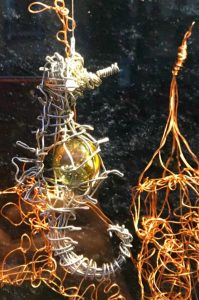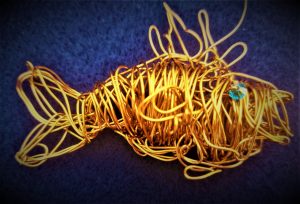Submerged Venice
San Marco, pesci
San Marco, fishes
filo metallico, inserti in cristallo
metal wire and crystal
L’installazione nasce da una riflessione su un articolo pubblicato nel Marzo 2022 dalla rivista “Le Scienze” intitolato: “Venezia Affonda” (M.Anzidei, A. Vecchio e F. Florindo).
Gli autori hanno sviluppato un modello per stimare l’aumento medio del mare a Venezia, usando dati e previsioni pubblicate dall’IPCC. Essi sostengono che tra 78 anni l’effetto dall’innalzamento dei mari, creerà un grande impatto sull’ambiente e sul patrimonio culturale delle città costiere. I risultati delle ricerche dimostrano che in assenza di interventi sulle emissioni di gas serra, il livello della laguna potrebbe aumentare di 82 cm entro il 2100. L’artista REsi Girardello ha considerato fosse urgente realizzare delle opere che potessero sensibilizzare, far pensare e forse promuovere studi e riflessioni sul tema.
L’opera è stata allestita in una MOSTRA IMMERSIVA realizzata in concomitanza con la Biennale d’Arte contemporanea 2022 e con GlassWeek
___
Gloria Vallese – Non si sa dove, in un qualche dove che sembra invisibile alla maggior parte della gente, gli scienziati contano il tempo che rimane. Poco, sembra. Ormai non più in uno spazio di secoli, ma di decenni, le città lungo le coste saranno inghiottite dal lento ma inesorabile innalzamento del livello del mare. Anche Venezia, questo prodigio della storia umana, questa strana e sempre nuova sorgente di incanto, con le sue stupefacenti delicate meraviglie, sarà sommersa? A giudicare dai crudi numeri, non solo sembra di sì, ma il conto si sta accorciando: c’è chi parla di 70 anni; qualcuno addirittura di 30. Il mondo, ignaro, forse scettico, continua il suo flusso quotidiano. Molti non possono decidere nulla; altri non decidono, o prendono decisioni sbagliate.
Anche il cuore di Venezia, la Basilica di San Marco, attende. Sempre più fragile, con l’aggravante di un’immane trincea che le si è scavata intorno da qualche tempo, e che attende anch’essa, riempiendosi lungo le settimane e i mesi d’acqua che va a toccare le delicate fondamenta della struttura. Un pericolo incalcolabile! Sarà il nostro tempo, insomma, a vantare il primato ignobile di aver messo la parola fine a questa struttura sopravvissuta per quasi mille anni? Resi Girardello, un’artista donna, si interroga. Da qualche decennio ormai si dedica a una straordinaria riscrittura del mondo attraverso una tecnica a radice femminile, il filo di rame lavorato all’uncinetto; e con quel filo lancia nell’aria foglie, pesci, fiori, architetture, figure umane, al tempo stesso pieghevoli e resistenti. Col suo strano mezzo tenace e delicato insieme, Resi Girardello interroga, fin dall’inizio della sua carriera, il mondo della natura e grandi temi della scienza: come le microstrutture viventi dell’universo, le infezioni trasmesse dai microrganismi (sì, le pandemie), il riscaldamento globale. Li traduce in superbe installazioni, preziose anche perché capaci di coinvolgere, con la loro meraviglia visuale, un pubblico che in prima battuta non sarebbe capace di digerire i ponderosi trattati, le tabelle e le equazioni degli scienziati, ma che può trovare così, grazie a un’arte sposata alla scienza, un punto di primo accesso. In questa stanza per Venezia sommersa, creata in occasione della Biennale Arte 2022, Resi Girardello fa della città fragile e minacciata un’analisi-autoanalisi della sua stessa arte, filo sottile capace di disegnare nell’aria le trame di un pensiero complesso, ma che rischia di soccombere alla sua stessa delicatezza, a una mancanza di aggressività che è poi quella stessa della natura. Una recente creazione, la Basilica di San Marco in filo metallico (‘Il Mare nel cuore’, 2021), riappare qui evanescente come un ologramma, questa volta fondendosi-confondendosi con le forme naturali delle barriere coralline, ugualmente meravigliose, e ugualmente condannate all’estinzione. Se il messaggio di fondo in sé non suona nuovo (anzi, purtroppo, si è quasi consumato nelle nostre orecchie, a quanto pare, tragicamente, senza esito), la grande forza di questa ‘stanza’ è di farci sentire fisicamente la fragilità minacciata: quella dell’artista, quella della città più amata del mondo, e quella del mare di tutto il pianeta, coi suoi abitanti animali e vegetali. Un piccolo spazio che amplifica magicamente una sinfonia altrimenti difficile da udire, destinata forse a interrompersi prima di quanto pensiamo.
In a somewhere unknown (a somewhere that apparently remains invisible to most people), the scientists are counting the time that remains. Not much, it seems. No more in a space of centuries, but of decades, the cities along the coasts in all the world will be submerged by the inexorable rise of the sea level.
Will Venice also, this prodigy in the human history, with its astonishing delicate wonders, be submerged? Judging by the crude numbers, not only it seems so, but the span is getting shorter: someone says, 70 years from now; some other, even 30. The world, unaware, perhaps skeptical, continues its daily flow. Some persons feel the problem, but can’t decide anything; others, who could, do not decide, or make bad decisions. Also the heart of Venice, the Basilica of San Marco, is waiting. More fragile than ever, because of the aggravating circumstance of a huge trench that has been dug around it some time ago. It fills up, over the weeks and months, with water that touches the delicate foundations of the structure; an incalculable danger! Will our age sign the end of this building which has survived for almost a thousand years? Resi Girardello, a woman artist, wonders. For a few decades now, she devoted herself to an extraordinary task, rewriting the world through copper wire entwined in a traditional woman’s technique, the crochet. With that one tiny thread, she throws leaves, fish, flowers, architectures, human figures into the air, in art creations which result at the same time frail and tenacious. Since the beginning of her career, Resi Girardello questions the world of nature and the great themes of science: the living microstructures of the universe, the infections transmitted by microorganisms (yes, the pandemics), the global warming. She translates all this into striking installations, also valuable because they are capable of involving, with their visual wonder, audiences that otherwise would not be able or willing to digest the ponderous treatises, the tables and formulas of the scientists, but who can find here their point of first access. In this room for Venice submerged, created on the occasion of the Biennale Arte 2022, Resi Girardello makes of the fragile and threatened city a theme of self-analysis, both of herself as a person, and of her own art: a thin thread capable of drawing the plots of a complex thought, but which risks to succumb to its own delicacy, to a lack of aggressivity which is that of the nature itself. A recent creation, the copper-wire Basilica of San Marco (‘Il mare nel cuore’, 2021), reappears here, evanescent like a hologram, this time merging with the natural forms of coral reefs: equally marvelous, and equally condemned to extinction. If the underlying message is not new in itself (indeed, it has almost worn out in our ears, apparently to no avail), the great strength of this ‘room’ is to make us physically feel the threatened fragility: that of the artist herself, that of the most loved city in the world, and that of the sea of the whole planet, with its silent and harmless inhabitants. A small space that magically amplifies a symphony otherwise difficult to hear, perhaps
destined to stop sooner than we think.
| HOME | ABOUT | ARTWORKS | EXHIBITIONS |
| NEWS | PRESS | SHOP | CONTACT |







